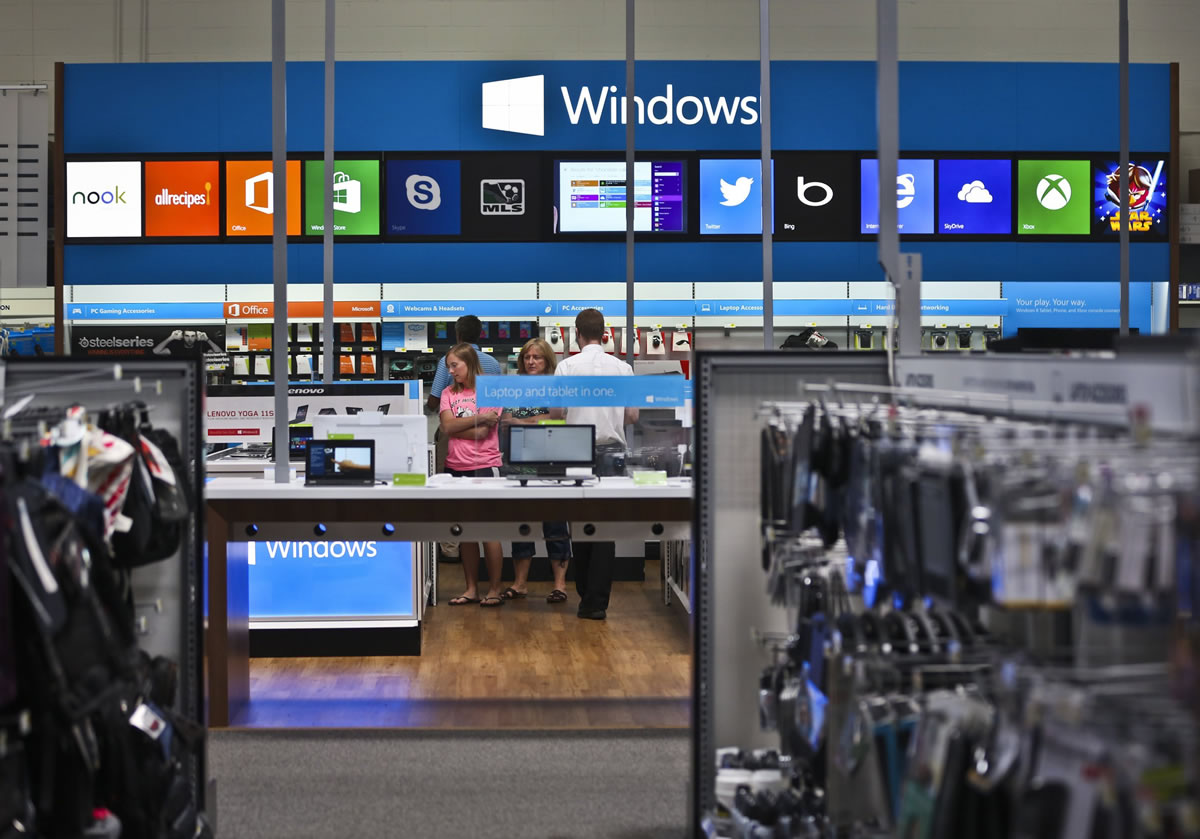The sign outside the big box in Richfield, Minn., says Best Buy, but the inside of the building looks more like a mall than a single store.
The usual Blue Shirts and Geek Squad agents scurry across the sales floor, but Samsung, Microsoft, Pacific Kitchen and Magnolia occupy their own domains within Best Buy. They have large product displays, dedicated checkout areas, and employees wearing shirts that are distinctively not blue.
Best Buy stores are becoming more complex these days as CEO Hubert Joly has aggressively pursued a “store-within-a-store” concept more common among department stores and Asian retailers.
“Best Buy is really hustling to find its strategic way forward,” said Robin Lewis, CEO of the Robin Report, a newsletter that tracks the retail industry.
The benefits are clear: Higher sales of popular brands plus the rent Samsung and others pay to Best Buy Co. Inc. equals higher revenue for the consumer electronics retailer. It’s a formula Best Buy appears willing to replicate with other manufacturers.
“We’re always working with our vendors to find new ways to provide the best shopping experience for our customers,” said Best Buy spokeswoman Carly Morris.
But in reality, the concept is untested. Does ceding space to Samsung and Microsoft drive additional traffic and sales throughout the entire store? Will a Samsung employee really give up a potential sale if a shopper visiting the Samsung Experience shop can’t decide between a Galaxy smartphone or an iPhone 5?
Best Buy, after all, has portrayed itself as the retailer whose highly trained Blue Shirts offer customers knowledgeable and unbiased advice on products that best suit their needs. On a larger level, Best Buy runs the risk of eclipsing the brand that matters the most: Best Buy.
“It’s a fine line,” said Brian Kelly, a Chicago-based retail consultant and a former top executive at Sears and Eddie Bauer. “They’ve got to make sure Best Buy is the brand of choice for customers. Going overboard with store-within-a-store could diminish the power of the (Best Buy) brand.”
One of Joly’s top priorities as he restructures Best Buy is to boost sales by redesigning store space. Specifically, he wants stores to stock higher-growth products that could boost sales per square foot, the ultimate measure of a retailer’s health.
Beneficial strategy
That’s where store-within-a-store concepts come in handy. Microsoft and Samsung are essentially leasing their spaces from Best Buy and each manufacturer controls their own pricing and merchandise decisions. That frees up Best Buy to concentrate on areas of the store, but it also benefits from Samsung and Microsoft’s investments in terms of sales and rent.
“It’s a weird kind of win-win” for the retailer and vendor, said Jeff Green, a Phoenix-based retail consultant. Microsoft and Samsung promote their brands without having to operate a full-scale store. For Best Buy, “it’s a way for them to get away from all of that square footage.”
Morris, the company spokeswoman, declined to disclose the financial terms of its deals with Samsung and Microsoft except to say that Best Buy made “joint investments” with Microsoft in training, in-store setup, and marketing.
But research suggests that stores within a store don’t just occupy space. A study by marketing professors at the University of Pennsylvania and Carnegie Mellon say the concept can boost sales of high-value products that require a degree of service and can’t easily be found somewhere else in the store.
For example, Pacific Kitchen, an upscale appliance chain purchased by Best Buy in 2006, trains its own sales force, which seems to be paying off with several quarters of double-digit gains in appliance sales at stores open for at least a year.
“These efforts to partner with vendors should improve service levels, secure access to the latest and greatest products, and keep more customers purchasing at Best Buy,” Gary Balter, a retail analyst with Credit Suisse, wrote in a recent research report.
Should vs. will
Should, however, doesn’t necessarily mean will.
Analysts like to say Samsung and Microsoft stores will bring buzz to Best Buy but whether that translates to additional sales throughout the store is far from clear.
Investors measure the value of a retailer in two ways: sales per square foot and customer traffic. Best Buy generates a seemingly robust $852 per square foot, compared to $303 for Target and $140 for J.C. Penney. But fewer people are visiting Best Buy stores, which means that $852 figure is likely to continue to fall unless the company can somehow reverse that trend.
“Best Buy needs to change those traffic patterns,” said Michael Dart, who oversees private equity and strategy practice at Kurt Salmon.
If executed well, a store-within-a-store concept can significantly boost the market value of a retailer if its overall sales and traffic go up, not just Samsung or Microsoft’s numbers, he said. For example, someone who purchases a Galaxy tablet might buy an accessory elsewhere in the store.



